Notes from a recent journey going counter-clockwise around Iran, visiting places such as Tehran, Shiraz, Persepolis, Esfahan, Yazd, Meybod, Meymand, Kerman, Mahan, Mashhad and more.
Touchdown in Tehran
Touchdown in Tehran, the capital of Iran. Imam Khomeini Airport was not the jolliest of places and the passport control was extremely tedious, but here we are.
The first thing I noticed in Tehran was the traffic. I’ve seen some crazy stuff in my days, cities such as Cairo and Bangkok are downright hilarious when it comes to traffic regulations and public safety, but this was probably even worse. I loved it.
We quickly dropped our bags at the hotel in Gohar Shad Alley and went looking for food close to midnight on deserted streets. It immediately struck me that the streets were completely empty on this fine Saturday evening in a city of millions. I guess everybody were at home, since there is no nightlife to mention. In fact, my Lonely Planet has a chapter “Nightclubs” for Tehran but the paragraph only consists of two words: “Dream on”.
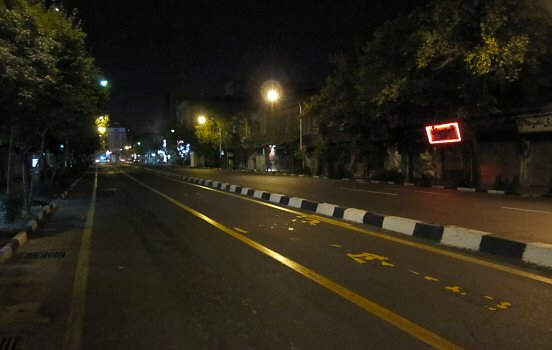 Saturday night in Tehran. Not a living soul in sight.
Saturday night in Tehran. Not a living soul in sight.
Onward to Shiraz
Morning in Tehran. After a horrible excuse of a coffee in Jamali Alley, the morning was kick-started with a fierce taxi ride through Tehran. I enjoyed chatting with the driver who really hated the city and played loud music. We drove past the gigantic Azadi Tower, which looked more like a white Sauron tower than a monument of freedom. As expected, the ride actually ended up with a car crash, making a big dent in my passenger door.
Later in the afternoon, we arrived to the city of Shiraz. Left the backpack at the hotel and walked across Hamzeh Bridge. The traffic was a bit less insane than Tehran (but only a bit). We saw a great dome in the distance and soon entered the magnificent Imamzadeh-ye Ali Ebn-e Hamze. The walls inside were covered with mirrors and the tomb of Emir Ali was located in the center. I’ve been told that Shiraz is one of the oldest towns in Iran and it sure felt a lot more conservative than Tehran.
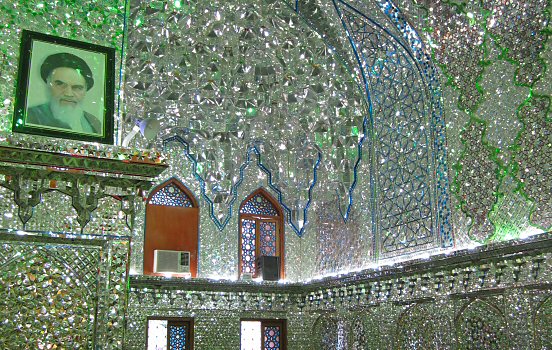 The impressive interiors of the shrine, as always under the watchful eye of Khomeini.
The impressive interiors of the shrine, as always under the watchful eye of Khomeini.
The ground outside the entrance was filled with tombstones, which cost a small fortune for the families of the deceased. A woman released gold fishes into a nearby pool, as a traditional wish for a happy life.
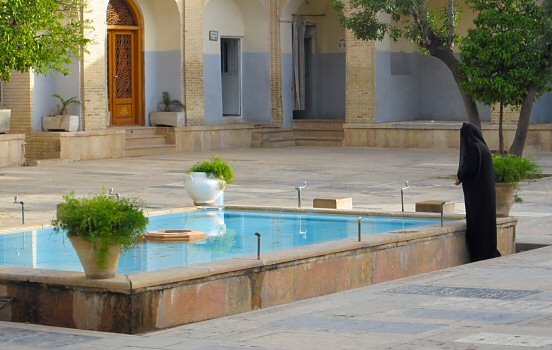 Chador-clad woman releasing gold fishes outside the shrine.
Chador-clad woman releasing gold fishes outside the shrine.
Walked north through Melli park where we saw a lot of tents. The Iranian people sure loves to picnic. I tried the odd local specialty Faloodeh, some sort of frozen starch lime juice with rose water. Weird but not bad.
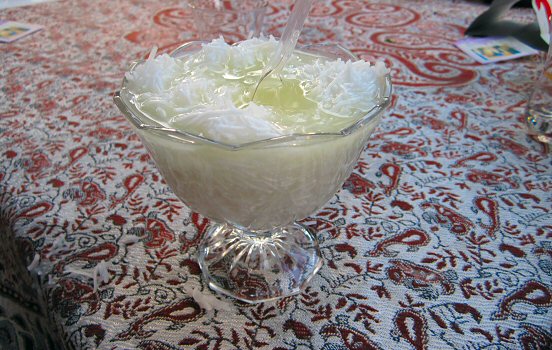 Faloodeh. Nuff said.
Faloodeh. Nuff said.
Our path led us to Aramgah-e Hafez, where the beautiful tomb of national poet Hafez brought lots of people into the night.
Getting past the crowd made me hungry, and after a long walk westbound we found the best kebab in town near the Gas Park. The fitting end to the evening was a furious cab ride home, which cost 20 000 rial but was more entertaining than any roller-coaster I’ve ever tried.
- Related blog post: Hunting for kebab in Shiraz
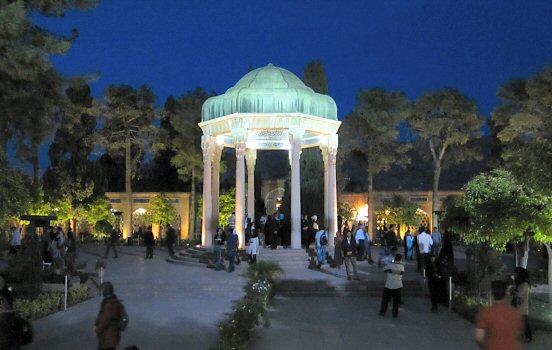 Tomb of national poet Hafez.
Tomb of national poet Hafez.
We read about a place which was described as “in theory, non-Muslims are not allowed”, so we had to check it out. It turned out to be Aramgah-e Shah-e Cheragh, a sanctuary on the spot where Sayyed Mir Ahmad was murdered in 835 AD. The imposing building was split into different sections for men and women by a wall. I found it sad that the entire tomb was placed in the male section, with only the short side facing into the wall for the women to touch. But they obviously weren’t prepared for the six-foot-four Swedish Godzilla to roam freely in there since I could easily see over the wall to the women’s side as well. We went to the innermost section where people were sleeping and chanting verses from the Koran.
We ended up at Daryache ye Namak, a salt lake outside of Shiraz. It was possible to walk quite far into the lake, which made my shoes look like they’ve been through a rough winter in Gothenburg.
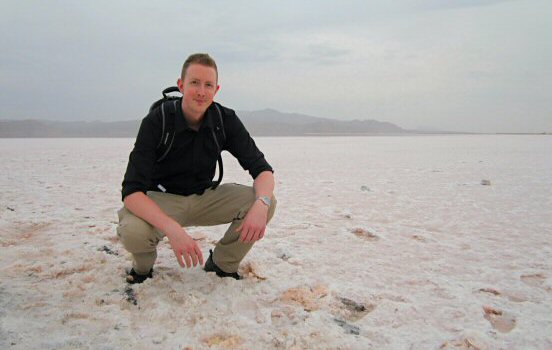 Across the salt lake, Daryache ye Namak.
Across the salt lake, Daryache ye Namak.
The winds of time in Persepolis
Finally time to visit Persepolis, one of the great places of the ancient world. It was once the ceremonial hub of the Achaemenid Empire with large temples, before Alexander the Great decided to burn Persepolis to the ground. It was probably in retaliation to Xerxes sacking Athens in 480 BC, about 150 years earlier. Talk about holding grudges.
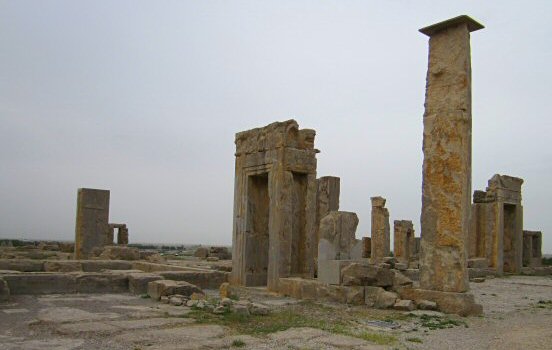 The remains of Xerxes’ Palace in Persepolis.
The remains of Xerxes’ Palace in Persepolis.
I especially enjoyed the beautiful Apadana staircase with several well-preserved reliefs. Unfortunately a lot of the items has been brought to the British Museum in London, but the imposing stone columns gave a hint of the former magnitude of this place.
Graffiti from visitors such as Welsh explorer Stanley (visited in 1870) were seen carved into the stone here and there.
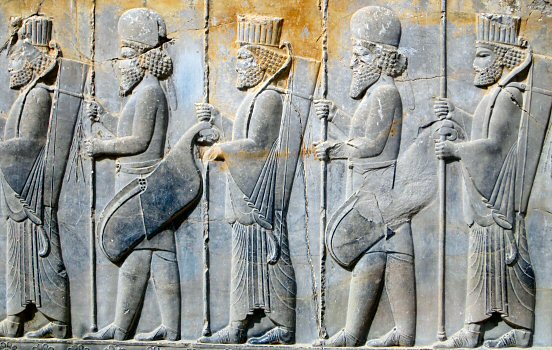 Ancient carvings at the Apadana staircase in Persepolis.
Ancient carvings at the Apadana staircase in Persepolis.
From the adjacent hilltop we had a great view of the entire palace area. These hills also holds the tombs of several kings, but even more imposing tombs were located at nearby Naqsh-e Rustam, where they have been cut into the mountain side.
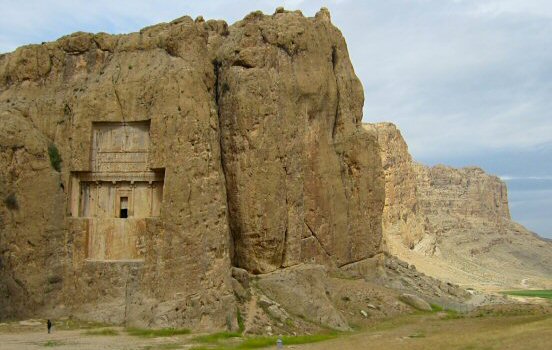 The tomb of Xerxes at Naqsh-e Rustam. Notice the human for scale.
The tomb of Xerxes at Naqsh-e Rustam. Notice the human for scale.
We managed to get a car to Pasargadae, the old capital city of Cyrus the Great. He was perhaps the greatest leader of ancient Persia, praised even in the Bible for his humanitarian rule. His large tomb is quite impressive, but unfortunately it had already been plundered when Alexander the Great visited the site in 324 BC, about 200 years after the death of Cyrus.
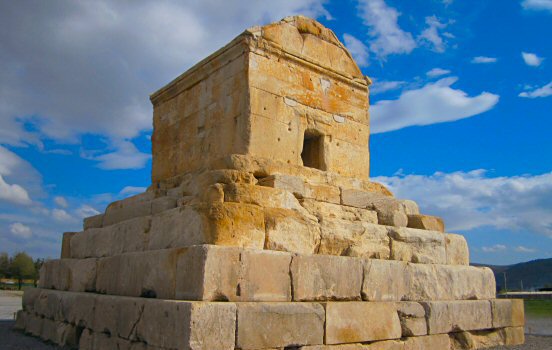 The tomb of Cyrus in Pasargadae.
The tomb of Cyrus in Pasargadae.
We explored the surrounding sites and felt like Indiana Jones when we found writings carved in columns in three different languages. The fortress of Toll-e Takht at a hilltop offered nice views of the area.
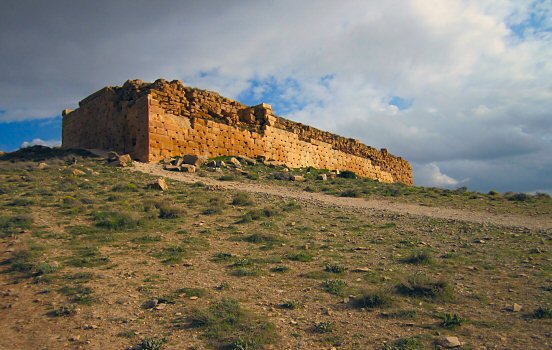 The fortress of Toll-e Takht.
The fortress of Toll-e Takht.
Desert camp
Time to leave the civilization and go south. After a few hours we entered the town of Firuz Abad where we found the ruins of an 1800-year old palace called Ardashir-Kwarrah.
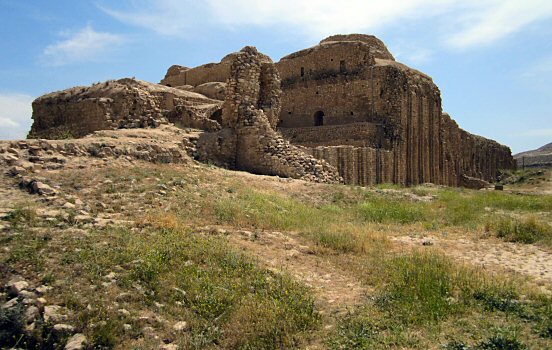 The ruins of Ardashir-Kwarrah.
The ruins of Ardashir-Kwarrah.
Among the deserted ruins were red papavers (opium poppy), a welcome splash of color in the otherwise barren site. The palace was once built by Ardashir Babakan, founder of the Sasanian empire.
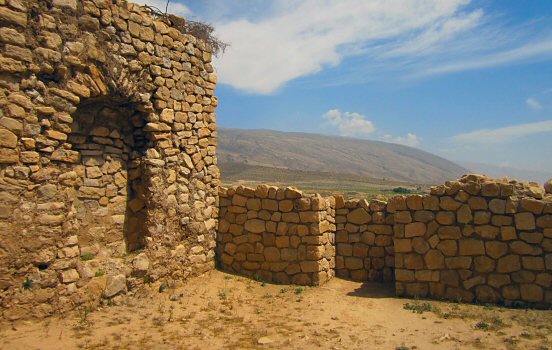 Inside Ardashir-Kwarrah.
Inside Ardashir-Kwarrah.
For several hours we rolled across steep hill roads which made the engine roar with displeasure. The temperature was rising and we rarely saw any people or settlements.
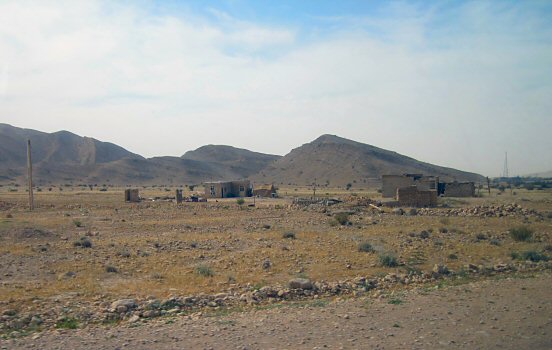 Settlements along the desert road in southern Iran.
Settlements along the desert road in southern Iran.
We finally stopped at a Kashgai nomad camp shortly before dying of the heat. The family was very friendly and we had tea sitting on a carpet they had woven themselves.
We tagged along as they were milking goats, picked berries from trees, farmed vegetables in the fields and made yogurt.
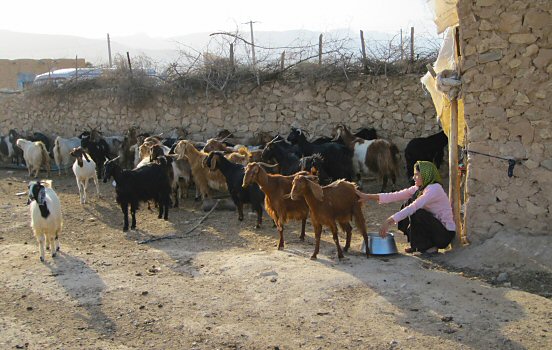 Staying with the nomads.
Staying with the nomads.
After nightfall I went on a walk alone and marveled at the impressive starry sky, completely free from light pollution.
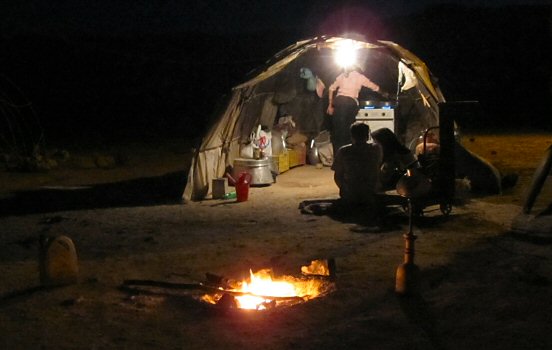 A beautiful night under the stars.
A beautiful night under the stars.
Towards Esfahan
I woke up freezing on a Persian rug with aching back. Behind a corner I saw the wicked rooster that kept me awake for hours, but luckily for him I was too tired to go hunting.
The nomad family baked very nice bread for breakfast and we thanked them for the short but very interesting stay, which really gave me some perspective on our lifestyle back home.
The car engine was not happy at all as it struggled once more to get across the hills. It was a very long journey but we finally arrived in Esfahan late in the evening.
We walked across the Si-o-Seh bridge with its 33 arches beautifully lit across the Zayandeh river. It seemed like a popular place for young people to hang out.
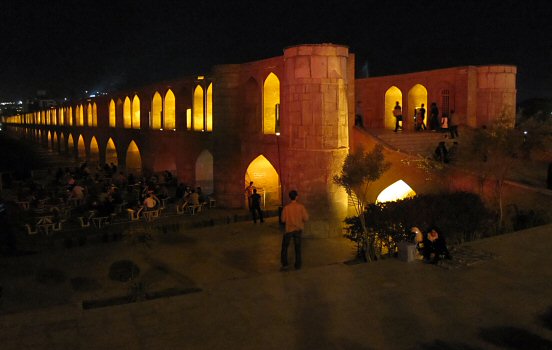 Si-o-Seh bridge in Esfahan.
Si-o-Seh bridge in Esfahan.
The next morning we managed to find our way to Imam Square, which is said to be the second-largest square in the world after Tiananmen Square in Beijing. There were lots of families having picnics in the grass and we got lots of attention since we were probably the only non-Iranians in the entire area.
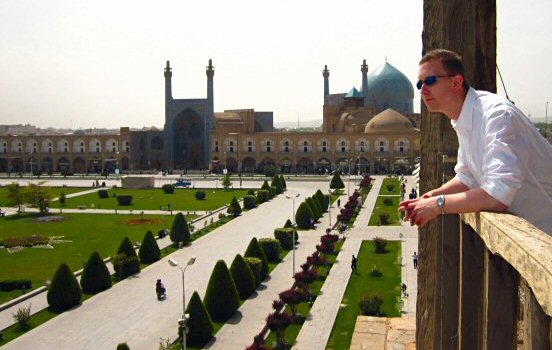 Reine searching for kebab at Imam Square.
Reine searching for kebab at Imam Square.
After enjoying a nice view from the palace we managed to find our way to Azadegan Tea House, well hidden in a small alley, where we had tea and admired the enormous amount of junk placed everywhere in the tiny place.
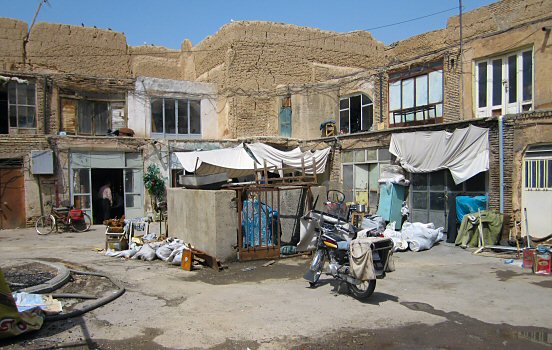 The well-hidden tea house in Esfahan.
The well-hidden tea house in Esfahan.
Other highlights of the day included a bowl of Dizi stew, beautiful mosques and getting stare-downed by an entire school class.
After a full day of walking across town and exploring the old Jameh Mosque, I had to try the Iranian national dish Fesenjun, with its special taste from walnut and pomegranate sauce.
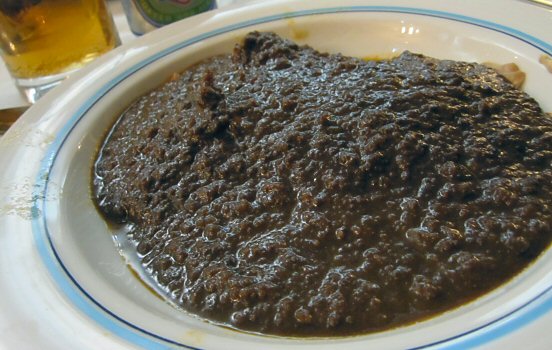 Fesenjun. It tastes better than it looks.
Fesenjun. It tastes better than it looks.
Then we got half lost in the bazaar area, until we found some sort of religious school with large Khomeini paintings on the wall. Deep in the basement we found the worst public toilet ever (a record that would last for only a few days until we reached Jowsam). That was our cue and we walked back to the waterfront for an sunset walk along Zayandeh River.
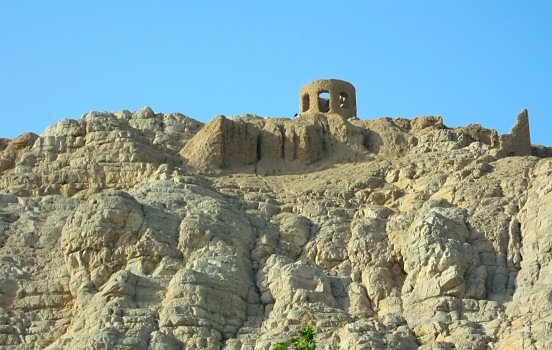 Ateshkadeh-ye Esfahan from below.
Ateshkadeh-ye Esfahan from below.
We spotted a cool mountain at the horizon and immediately went there to climb up. At the top we found the old Zoroastrian fire temple Ateshkadeh-ye Esfahan, where we sat down in the crumbling mud brick arches and had a fantastic view of the surroundings.
Back down on the ground we went looking for pigeon towers, once used to hold thousands of pigeons for a supply of guano used as fertilizer for the city’s famous fields of watermelons. More than 700 of the once 3000 towers remains, but the most interesting part was the way there that lead us through a pitch black tunnel filled with animal skeletons.
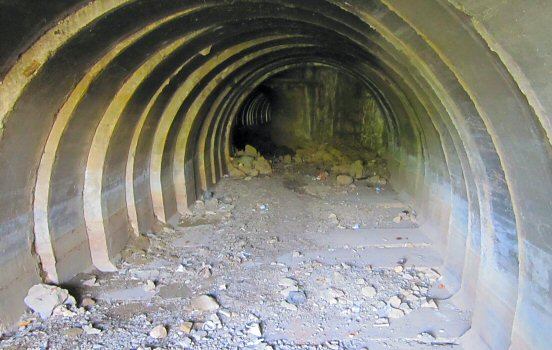 Searching for pigeon towers is not for the faint of heart.
Searching for pigeon towers is not for the faint of heart.
Back in civilization at Imam Square we joined the picnic families while waiting for the sun to set over the glimmering turquoise mosque domes. As always we drew more attention than an ice cream vendor in Sahara.
We managed to sneak into the Abbasi Jame Mosque at dusk and sat below the minarets as they echoed with loud prayers while men poured into the big chambers, praying on big rugs on the floor.
To Yazd
I really liked Esfahan, but now it was time for a completely different experience. We found our way to the bus station, where we entered an old bus mostly held together by duct tape. After a steaming ride through the desert we finally arrived at the city of Yazd.
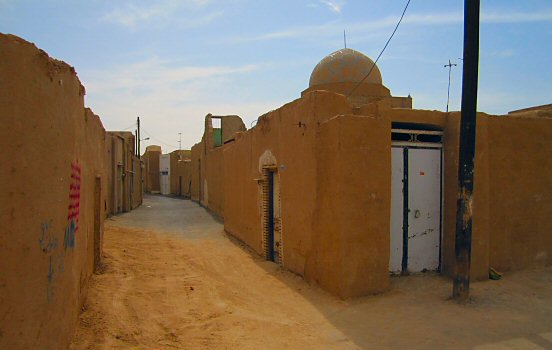 Endless mud brick alleys.
Endless mud brick alleys.
Yazd is located in the middle of the desert. The city was a popular travel hub along the Silk Road, so extra tall minarets were used as landmarks for the ancient camel caravans. It turned out to be very easy to get lost in the mud brick alleys.
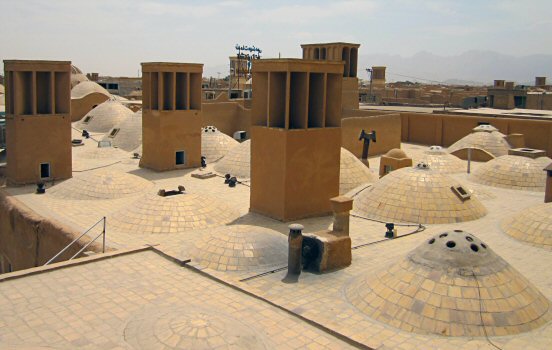 The roofs of Yazd are covered with badgirs.
The roofs of Yazd are covered with badgirs.
We went up on the roof of a mosque and admired the roof tops which had a lot of “badgirs”, ingenious constructions acting as medieval air conditioning systems.
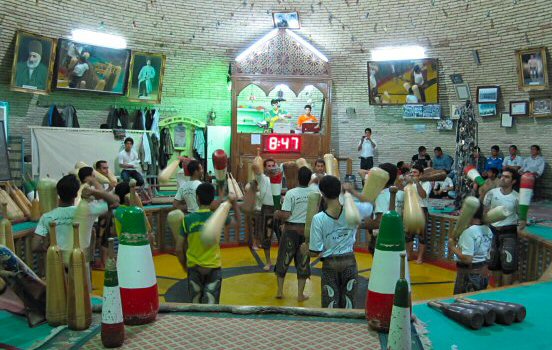 Practitioners of Zurkhaneh in action.
Practitioners of Zurkhaneh in action.
The evening ended at a weird place. Saheb A Zaman Club Zurkhaneh was an old water reservoir built in 1580 but these days it is used as a dojo for practitioners of Zurkhaneh, a thousand-years old mix of religion and martial arts. A referee recited poetry of Hafez and beat the drum like crazy to provide a sonic backdrop for the performers whirling around in the center pit.
- Related blog post: Getting lost in Yazd
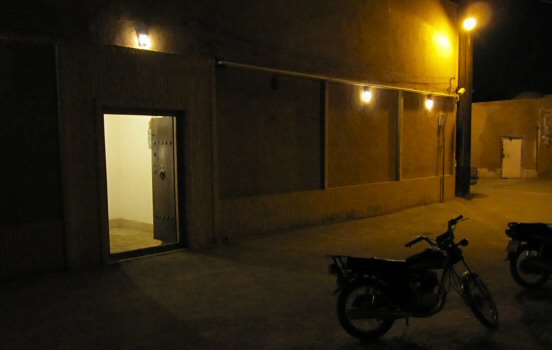 The quite discrete entrance to our hostel.
The quite discrete entrance to our hostel.
Chak Chak and Meybod
We drove for hours into the desert before arriving at a mountain. Far up on the slopes we saw Chak Chak, the old fire temple which is the most sacred pilgrimage shrine of the Zoroastrians.
Ascending the slope was quite tough in the desert heat, but we finally reached the shimmering bronze gate. An old man unlocked the gate and we entered the shrine barefoot. To my surprise and delight, the floor tiles were cold and wet. Next to the eternal flame was a small drizzle of water next to a very old and gnarled tree. A most unexpected sight in the middle of a desert.
Later in the day we arrived in Meybod, another old trade center along the Silk Road. From the top of the Narein castle we had a great view of the mud brick city which felt really ancient.
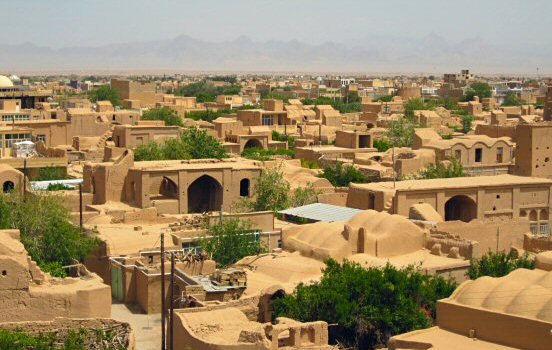 View of Meybod from the Narein castle.
View of Meybod from the Narein castle.
Passed through a caravansedai, which used to be sort of a camel motel, before we got to Yakh Dan, a mud brick house built to store ice during the summer. I climbed down into the egg-shaped pit, it was actually quite cold and the chamber gave a nice echo.
The journey east to Meymand
In the early morning we climbed to the top of a Tower of Silence, a place where the Zoroastrians placed their dead so vultures could pick their bones clean. The remains were then stored in small alcoves around the tower.
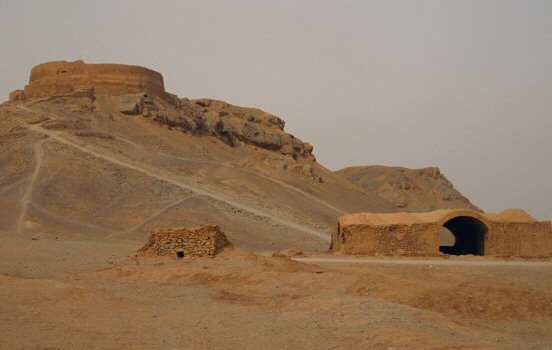 A Tower of Silence with remains of Zoroastrian buildings.
A Tower of Silence with remains of Zoroastrian buildings.
The day became endless hours along deserted roads through the barren stone desert. Stopped for gas in Shak-n-Babah, a chaotic trucker stop where the drivers fought for access to the pumps. I noticed several American Mack trucks among them, but they were quite old so I guess they were imported during the Shah era. This is also where I found the Worst Public Toilet Ever. Unfortunately I didn’t bring any ceremonial plaque for the occasion.
We finally arrived at cave village Meymand in the evening. It felt a bit like the Flintstones when we entered the cozy cave that would be our home for the next few days.
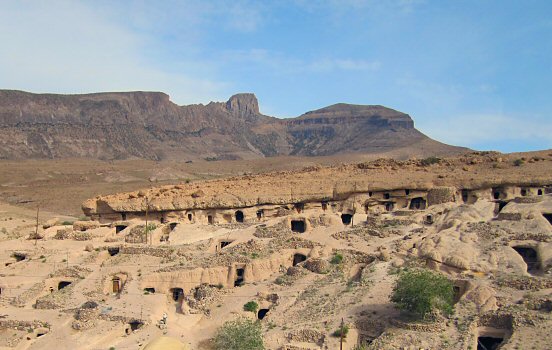 The cave village of Meymand.
The cave village of Meymand.
Went for a walk in the small village, passing the school building with Khomeini painted on the wall. There are only four children in the village so I guess they have plenty of space. I bought some peanuts from a toothless old woman and had tea in a cave sitting on a tree log.
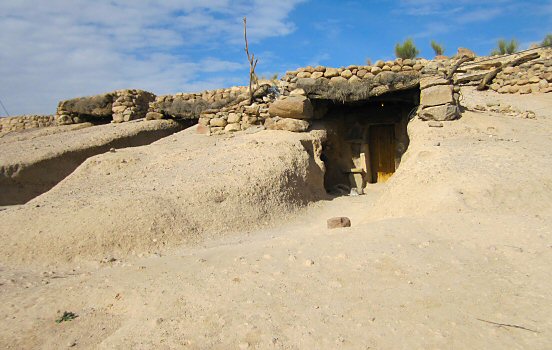 Our cozy cave in Meymand.
Our cozy cave in Meymand.
Lost in Meymand
Despite the hard surface I was surprisingly alert in the morning. Splashed some cold water in the face, donned the packing and went off trekking in the surrounding hillside. Our local guide was a young man named Ali, smiling all the time as he climbed the slopes with the energy of a mountain goat. A black dog followed us anywhere we went, but always at a respectable distance.
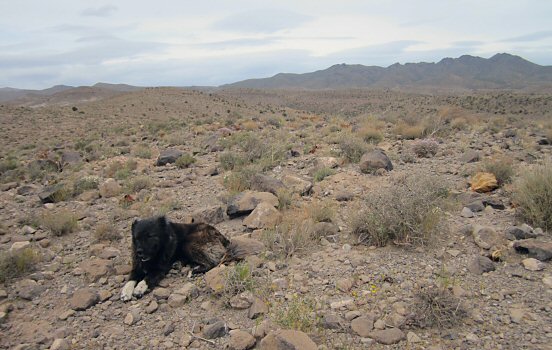 The poor black dog followed us everywhere we went.
The poor black dog followed us everywhere we went.
Along the way we came across farmers who gave us almonds, and later we stumbled upon a family picnic where we were instantly invited to share their abundance of tea, dates and bread.
After a few hours of walking we were invited to a small hut where we had omelet with dates, and of course more tea.
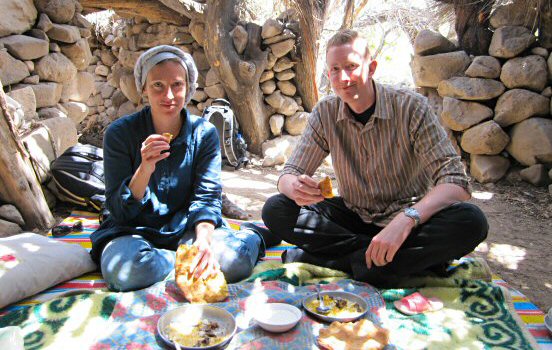 Invited for tea in a village somewhere.
Invited for tea in a village somewhere.
Arriving in Kerman
After several days in a quiet cave, it felt like a shock to arrive in Kerman during the afternoon, a busy town where the traffic was (you guessed it) really crazy.
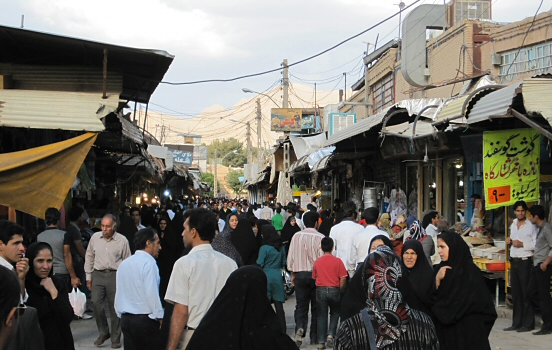 The bazaar in Kerman.
The bazaar in Kerman.
After leaving the bags at a dirty hotel we walked through the bazaar, where we found a very nice tea house located in an old hamam (bathing house). I tried the local cookie Kolompeh while two men played music in a corner and several visitors leisurely smoked on water pipes. Civilization, how I have missed thee.
We were later invited to a really nice family where we had good things to eat. I am constantly amazed at the hospitality of the Iranian people.
Exploring Dasht-e Lut
The city of Bam once had a beautiful citadel, but it was destroyed in the 2003 earthquake so we went to the nearby town of Rayen instead. It also has an old mud brick citadel which is nearly as impressive as the one in Bam, with a nice backdrop view of snowclad mountains.
Next stop Mahan, where we visited the mausoleum of sufi leader Shah Ne’emat Ollah-e-Vali. My friend got one of his usual bright ideas and soon we were climbing up one of the twin minarets! It was quite narrow but worth the hassle since it gave a great view of the turquoise tiled dome and rest of the city.
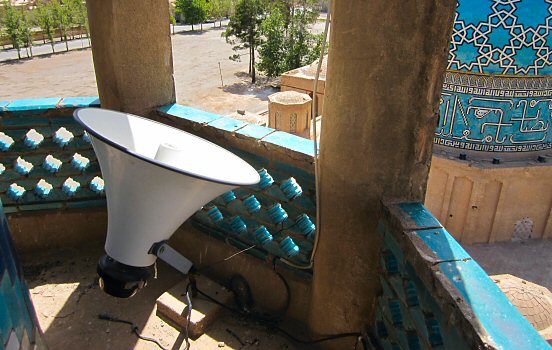 Unusual place #23: The top of a minaret.
Unusual place #23: The top of a minaret.
After meeting a red snake in the toilet, we took off into the Dasht-e Lut.
The Lut desert is the place where they once had the highest temperature ever measured at +70 degrees Celsius. It is also famous for the kaluts, big sand castles which reminded me of Monument Valley in North America.
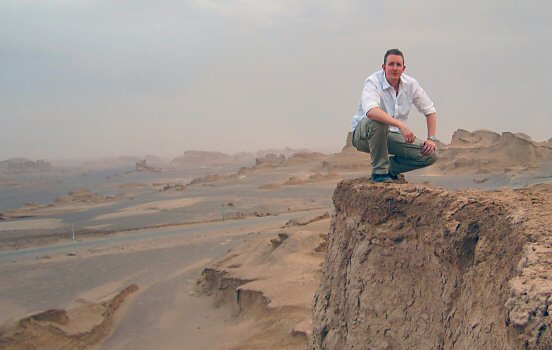 Exploring kaluts in Dasht-e Lut.
Exploring kaluts in Dasht-e Lut.
After a fuming hot drive for hours, it was finally time to discover what really lurked beyond the endless desert horizon, so we left the vehicle and started to ascend the mighty slopes of the kaluts. We sat down on a ridge and enjoyed the sunset over the kalut horizon.
Northbound train
Time to put on the backpack once again and head for the train station. The station of Kerman turned out to be as chaotic as expected, but as soon as we settled in our cabin, things got better. We were offered tea by the train steward and there were even some strange cookies. The barren landscape passed outside the window but at least there were pretty mountains and even the occasional wild dromedary.
The train stopped in the evening so passengers could get off and say their prayers. We were likely the only people left in the train.
We also had an ongoing feud with the cabin next door regarding the wagon temperature. The women clad in heavy chadors thought that the fuming desert heat was too cold and insisted on increasing the temperature. I woke up in the middle of the night, close to fainting from the heat before I managed to crawl to the window and push it open for cold air like a fish on dry land.
Entering Mashhad
Our night train arrived in Mashhad early in the morning. This is a pilgrim city close to Afghanistan which holds the shrine of Imam Reza, the eight Imam. The other eleven are buried in Iraq and other places, so this is the holiest site in Iran.
As non-Muslims we were not allowed to enter the innermost sanctum, but we watched from a distance as large crowds gathered to pray. The shrine is like a city within the city, filled with domes, fountains and courtyards. The area is so large that there is even a freeway intersection below it.
What to do next? Explored the bazaar area, had great kebab and got free cookies!
 Having awesome kebab in Mashhad.
Having awesome kebab in Mashhad.
Back to Tehran
In the morning we went back to the train station of Mashhad, which was fortunately better than Kerman.
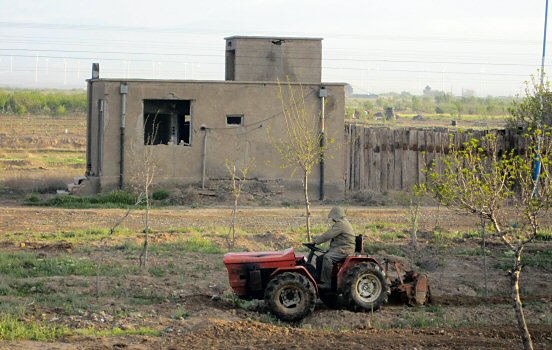 One of the amazing train stations.
One of the amazing train stations.
The westbound train ride went pretty smooth and I saw beautiful mountains in the countryside, including Fuji-shaped mountain Damavand in the distance as we got closer to Tehran.
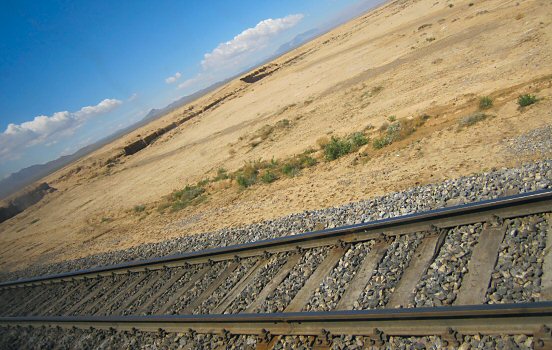 On the track towards Tehran.
On the track towards Tehran.
After what seemed like an eternity, we were now finally back in Tehran! The train station was pretty busy, but we got into a cab that took us north through insane traffic. It felt like having a cinematic car chase in a roller coaster. I loved it and my grin was still off the charts even as we reached the hotel.
The streets of Tehran
Woke to the sound of prayer chants at 5 AM. Today it was time to explore the northern part of Tehran. The entire city is built on the slopes below snowclad Alborz mountains and for half an hour we traveled constantly uphill. The mountains in the north turned out to be of great help for orientation since they are visible from most places in the city.
We found our way to the Sa’d Abad Museum, the luxury complex where the shah used to live. Only the legs remained of the statue of Reza Shah in front of the White Palace. Had a look inside the various palaces and weapon museums to learn more of this turbulent era.
Tehran is the largest city in the Middle East and today it really lived up to the name as we passed lots of blocks and it just never seemed to end. The National Museum turned out to be a disappointment though. Only a few of the items were from Persepolis, as the rest had unfortunately been shipped to British Museum in London.
- Related blog post: Tales from Tehran
Epilogue
In conclusion it was an interesting journey. Some parts of the country will force you to leave your comfort zone and it can unfortunately be quite challenging for female travelers, but I found the people to be very friendly and the sights are nothing short of spectacular.
Related posts

20 comments
Wohow! Awesomeness!!! I’ve been longing for this! It begs a few questions though: What are the other 22 unusual locations? How did the sheep brain REALLY taste??? Did you finish it? Pomegranate beer sounds pretty interesting, I must say… And, how did you ned up finding all these super intresting locations? Was it an organized trip, or did you organize it yourselves? Regardless, very very cool…
The other 22 will hopefully be covered in future posts here. :) The brain tasted weird with a texture similar to mushroom, but the plates were quite empty afterwards if I recall correctly. It was a trip with a native guide, since I think it would be very complicated to travel around this much on your own as a non-Farsi speaking foreigner.
Great storytelling, perhaps you should write for lonely planet instead ;)
I’ve got a workmate who “specializes” in traveling to really strange and preferably dictator lead countries. A few years ago he went to North Korea and the little crowd of westerners were followed by a camera team at all times. He got a DVD-copy of the “feature film” and I made copies form it. I’ve still got it somewhere, talk about strange! The traffic was the absolute opposite of what you’ve seen: 8 lane highways with no cars as no one is allowed to own cars…
Thanks Bollman! Maybe I will try that some day. :)
Haha, I guess that kind of movie needs an epic soundtrack. Strange that he got a copy, I thought photography and filming were very restrictive there?
I just stumbled across your blog — I just moved to Stockholm from the US, am also a .NET developer, and am Iranian. :) My last visit to Iran was when I was 2 years old so I am hoping to return again. As a citizen, I have to wait for my passport to be issued before I can travel there. So I’m curious how you were able to obtain a travel visa to wander around freely, since I was under the impression you need to be part of an official travel group or have some kind of business purpose to visit if not a citizen. Or perhaps that is only a requirement for US citizens?
Anyway, I enjoyed reading about your trip, thanks for posting it. It’s great to read about someone’s travels to Iran with an open mind, since there is certainly a lot of negativity floating around. I am excited to visit again soon.
I got my travel visa through the Iranian embassy in Stockholm with help from a Swedish travel agency, making it an official travel group. I suspect that it would be much harder (if at all possible) without the agency.
I hope you get the chance to visit the country soon!
In the name of God the Merciful
Hi Muhammad and Al Muhammad
Hello
I Cant write English good but Google translation gave me some help
I live in City Shahr-e-babak near Meymand stone village ;
I’m very glad that you visited my country,Islamic Republic Of Iran, and the city .
I was pleased to see your website
Bye
Thank you Mohammad!
Persepolis was actually built by Darius the great and Xerxes completed it ,Alexander,after he barbarically invade to Persia he burnt Persepolis with peoples in it just because his wife drank him and encouraged him to burn down the city
About 300 spartans ,They weren’t 300they were more than ten thousand as a matter of fact 300 of them were Spartan
One more thing ,you missed Pasargad ,the tomb of the first king who wrote human rights declaration ,Cyrus the great
I just reread this blogpost and I can only say that this trip was pretty awesome! :)
Navid: Actually, we did visit the tomb of Cyrus.
SALAM Reine,
its really awesome…i was just browsing the info on iran..fortunately i gone through this..
i felt very lucky after seeing it.
and i must say Day3 was truely awesome….thanks and god bless you!!
Hi every body , I’m from iran, I live in tehran, I’m studying MBA, but originally I’m from shahr-babak near meymand village, it’s my pleasure to help you if you come to visit meymand ,I can make your journey better and more enjoyable.
best wishes
i really enjoyed
good luck
your photos are amazing but you just visit the eastern part of Iran. I am an Iranian anthropologist and i propose you to visit the north and west part of Iran. in these parts you will find another civilization, clothes, language, markets,…..
01 Jul 10, 2012 15:34 Heyho you lazy bloggers,happy to see that you enjoy Iran as much as we did. Yazd was amzinag, Iran was amzinag. We especially realize that after arriving in India. We will probably make it to our final destination in about three days, wow. Unfortunately, we did not reach you on your mobile phone while being in Iran we wish you all the best for the rest of your journey and that it never ends ours does now:-)!All the best,Simon & Simon
Har drömt om att åka till Iran i flera år! Så inspirerande att läsa om andras upplevelse, även om det var några år sedan :D
En rejäl runtur gjorde ni också!
Hi, Why did not you visit to Shapour statue and ancient city of Bishapour? It’s really surprising to see such a huge statue in a cave at the top of a mountain…
Negar: Unfortunately I missed that one. Thank you for the tip, maybe next time. :)
1 USD is equivalent to about 14 South African Rands.
Leave a reply